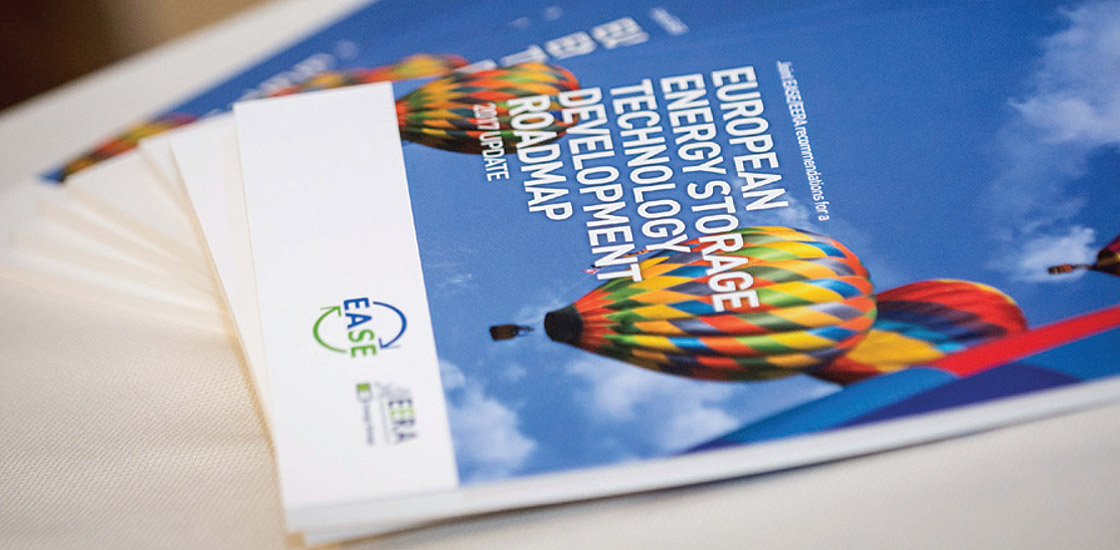Energy storage technologies are essential for the transition to a decarbonised energy system. Energy storage technologies allow us to decouple energy generation and consumption, both geographically and over time. They can provide flexibility at various time-scales, from seconds and hours to weeks and months.
Storage capacity will be vitally important once electricity systems are dominated by variable renewables, meaning that generation cannot be dispatched to match (predicted) demand. Even now, as we integrate more and more renewables into the system, energy storage can help the system function more securely and efficiently while extending the life of existing assets (for example grid infrastructure). Energy storage can also support decarbonising the heating, cooling, and transport sectors. Finally, storage can empower consumers to participate actively in the electricity market by generating, storing, and selling electricity.
In order for energy storage to fulfil its vast potential, we need a range of cost-effective, efficient energy storage technologies. No single technology will be able to meet the challenge of providing system flexibility at different time-scales. This is why there are many different storage technologies on the market or in development today: pumped hydro storage, flywheels, batteries, supercapacitors, power-to-gas, smart electric thermal storage, molten salt storage – the list goes on. Each technology has different advantages, making it suited to a particular set of applications.
A ROADMAP BACKED BY INDUSTRY AND R&D
Given the vast array of different energy storage technologies and the diverse players working on them, there is a need to gain a clear overview of each technology’s current status and R&D challenges. Then, we can work to align research, development, and deployment (RD&D) efforts and issue concrete recommendations for policymakers.
This is the idea behind the EASE-EERA Energy Storage Technology Development Roadmap, which was first published in 2013. Given the rapid advances in storage R&D, a comprehensive update to this roadmap was issued in October 2017. The roadmap is a joint effort of the European Association for Storage of Energy (EASE) and the Joint Programme on Energy Storage under the European Energy Research Alliance (EERA). It includes contributions from over 80 experts.
The roadmap's aim is to strengthen Europe’s research and industrial competitiveness in the energy storage sector and to ensure the availability of cost-effective storage technologies for the energy transition.
PRIORITIES FOR STORAGE TECHNOLOGY DEVELOPMENT
The roadmap has a dedicated section for each group of storage technologies, which identifies the challenges, opportunities, and R&D priorities of each technology. Covering all of these technologies in one roadmap allowed us to identify cross-cutting R&D priorities. Cost reduction is the highest R&D priority across all energy storage technologies. This can be achieved through an increased focus on materials research, manufacturing processes, and efforts to improve integration with other system components. Another overarching theme is the need to research energy storage business cases and to clarify the technical requirements and economics of aggregating different storage services. Additionally, the roadmap identified hybrid energy storage systems (combining two or more technologies into one storage system) as a top research priority.
Finally, a key priority is to remove the regulatory barriers that are currently holding back the deployment of storage in Europe, as this will open the door for large-scale deployment and commercialisation of storage technologies, which in turn will result in economies of scale and cost reductions.
RECOMMENDATIONS FOR R&D
Finally, EASE and EERA identify recommendations for R&D policies and regulatory developments to support the development and large-scale deployment of cost-effective energy storage technologies. These could feed into the post-Horizon 2020 research framework and be considered for initiatives such as the recently launched European Battery Alliance.
Our short-term policy recommendations are to:
- develop a strategic energy storage plan for Europe
- set up demonstration and pilot programmes focused on grid integration of relatively mature technologies
- demonstrate the ways in which storage can provide energy services and monetise the added value to the system
- support materials and equipment research, and
- investigate new designs for hybrid energy storage systems
Another important consideration that is underlined by the roadmap is that we cannot and should not identify winners and losers among the different storage technologies. Each technology has unique benefits and applications, and we will need both fast-reacting, short-duration storage as well as longer-term (weekly, monthly, seasonal) storage in a decarbonised energy system. Being able to choose from a diverse array of cost-effective storage technologies will benefit the entire system. This should be the central tenet of the EU’s R&D efforts as well as policymaking in the storage sector more broadly.
The EASE/EERA Energy Storage Technology Development Roadmap can be downloaded at: http://ease-storage.eu/ease-eera-storage-technology-development-roadmap-2017-hr/

About EASE:
The European Association for Storage of Energy (EASE) is the voice of the energy storage community, actively promoting the use of energy storage in Europe and worldwide. It supports the deployment of energy storage as an indispensable instrument within the framework of the European energy and climate policy to deliver services to, and improve the flexibility of, the European energy system. EASE seeks to build a European platform for sharing and disseminating energy storage-related information and supports the transition towards a sustainable, flexible and stable energy system in Europe.
EASE – European Association for Storage of Energy
Avenue Adolphe Lacomblé 59/8,
BE–1030 Brussels
Tel: +32 (0)2.743.29.82
Website: www.ease-storage.eu
Twitter: @EASE_ES
Email: info@ease-storage.eu